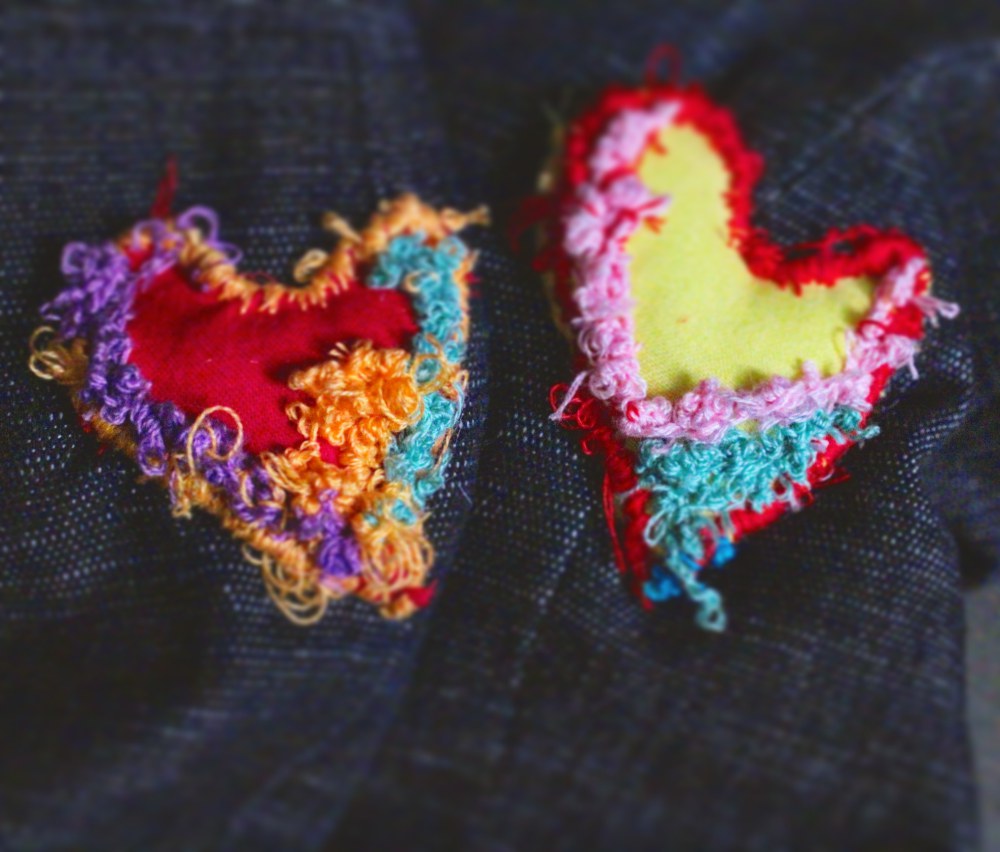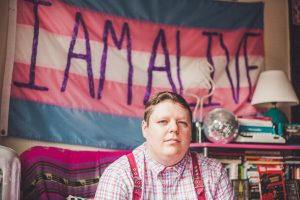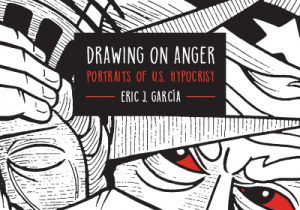Leslie Rose is a textile and performance artist who creates domestic spaces in public and transforms damaged garments into treasured garments of wearable art through her project Gardens in Open Spaces. Her pieces blossom as they commemorate the stories of wearers and inspire conversation. Rose is a working-class disabled transwoman and a sex trafficking survivor who has experienced periods of homelessness, and she draws on these experiences as she interrogates the nature of domestic spaces, access to public spaces, the gendering and invisibility of certain types of labor, and how to navigate the effects of trauma. Because she is often unable to leave her apartment due to her disability, sharing her project on social media and through those who have commissioned wearable pieces has become part of her performance. You can follow her on Instagram using the tag #gardensinopenspaces.
UPDATE: Since this interview, Rose suffered a heart attack and has launched a campaign to help her meet medical and living expenses while she recovers.
This interview has been edited for clarity and conciseness.
Jennifer Patiño Cervantes: How did your project Gardens in Open Spaces get started?
Leslie Rose: So Gardens in Open Spaces was an idea that I first had back in college, built around decorating holes in my clothes as opposed to just trying to close them up or getting rid of them. But it didn’t really come to full force in my mind until the summer of 2017 when I was in too much pain to leave the house and my only company a lot of time were these little moths that would get into my room. And because I hallucinate a lot, I really sort of identified them with my angels that were surrounding me. And by the end of the summer, all my clothes were full of holes and I wanted to think of a way of staying in conversation with these animals even though they weren’t in my room anymore. I wanted to find a way to feel like I was a part of that process of renewal and regeneration that Nature always seems to find new way to do. And then Gardens in Open Spaces was really coming from — I’d spent a lot of time embroidering flowers that summer because they’re my favorite thing and I wasn’t able to garden. And so I would occasionally be able to walk to my neighbor’s flowers and spend a lot of time smelling them and also we were keeping bees on the roof so I would visit the bees as they were pollinating and I would talk to them and thank them for their work. I really wanted to keep that energy — that life is always able to grow wherever there’s a space.
And then the other aspect of it was around homelessness. So I had, you know, I have been poor for most of my life because my parents trafficked me as a kid, extorted a lot of money out of me as an adult, and multiple times drove me into homelessness. And so the few things that I continue to own, I placed a lot of value in … When something’s ragged I don’t have to throw it out. I can turn it into something beautiful and when possible, I’d do it in public spaces because my homelessness was such a part of me, my identity now. But I think a lot of people tend to tune people out in public spaces, in bus stops, libraries, or cafés where homeless people tend to spend all day. And I wanted a way to make it really visible, how easy it is to make a public space a domestic space and find a way to really acknowledge the power of people who can survive despite any odds, how that embodies the force of nature and how our stories are unto themselves.
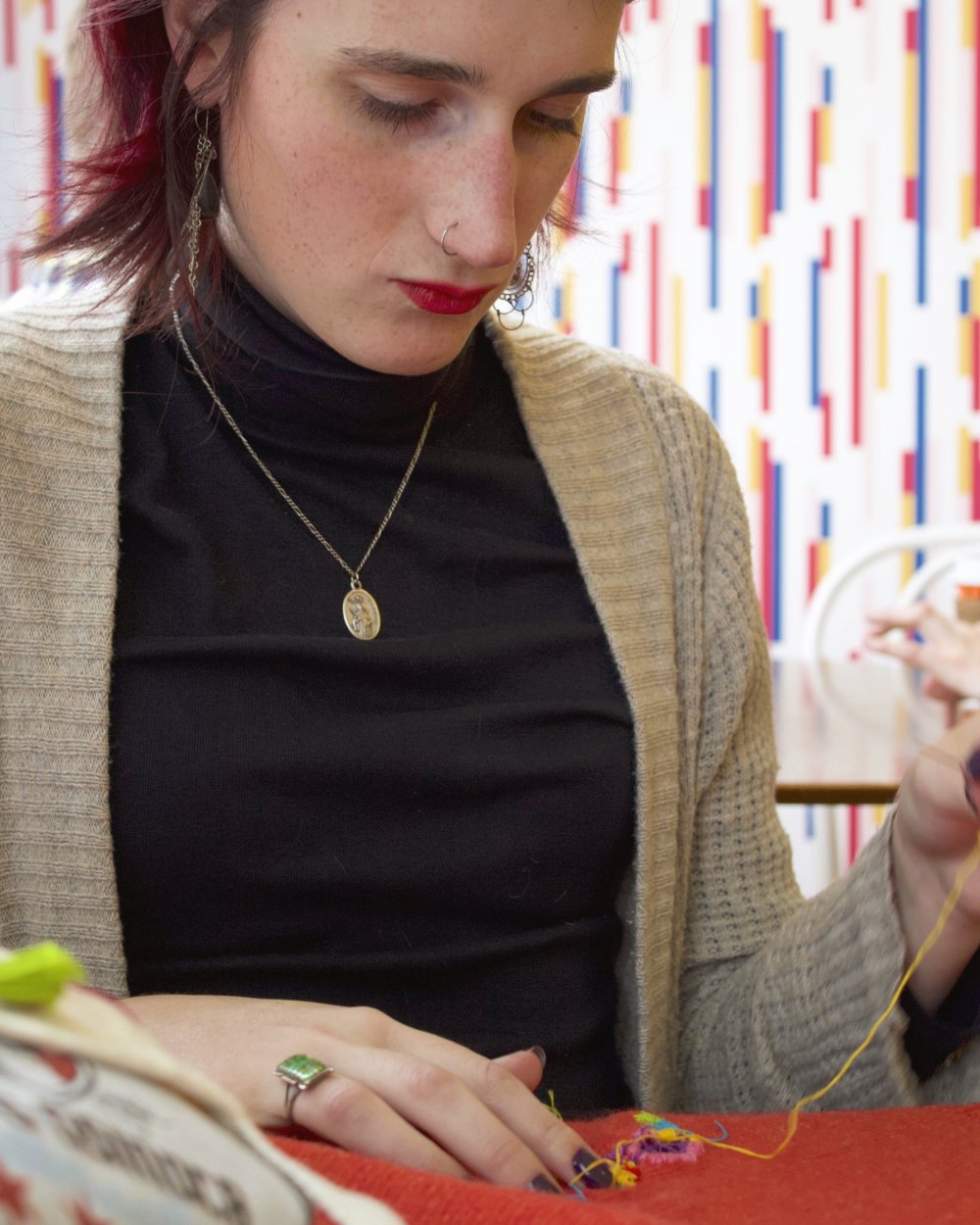
JPC: How does the performance aspect of your work bring the domestic space into the public sphere? Where does it come from?
LR: Particularly because needle work is so heavily associated with femininity, especially in a European context, like needlework in fine arts were reserved for the clergy. Or women who were quote-unquote “saved” from prostitution, then put to work making lace for businessmen. And that was how they “saved” them while paying them pennies. And so there is this longstanding tradition of undervaluing anything having to do with textiles and always trying to pay as little as possible for it. There’s also a long standing tradition of associating anything to do with textiles with women’s work, which helps you devalue women as well. And so obviously that comes under the domestic sphere because we’re talking about labor that is undervalued and is essential for daily life.
And we have such an attitude of trying to make it invisible. We ship it off to other countries. We try to use prison labor. We try to get it as cheap as possible, and we try to divorce it from us as much as possible, and here, I’m bringing it into spaces where people normally would feel very comfortable and secure. So they are already creating like a domestic space. It’s the doughnut shop and you’re sitting there with your cup of coffee on your phone or whatever. But here I am, forcibly taking all of these parts that are associated with domesticity that are always invisible, and also doing it in a public space like a homeless person always has to do. And I think there’s real power in being able to make both of those things present while making art that makes people remember me … When I was homeless all I wanted to do was survive and not be bothered by anyone. And I was really good at just blending into spaces. And now I feel so much power because I don’t feel like I have to hide that part of myself anymore.
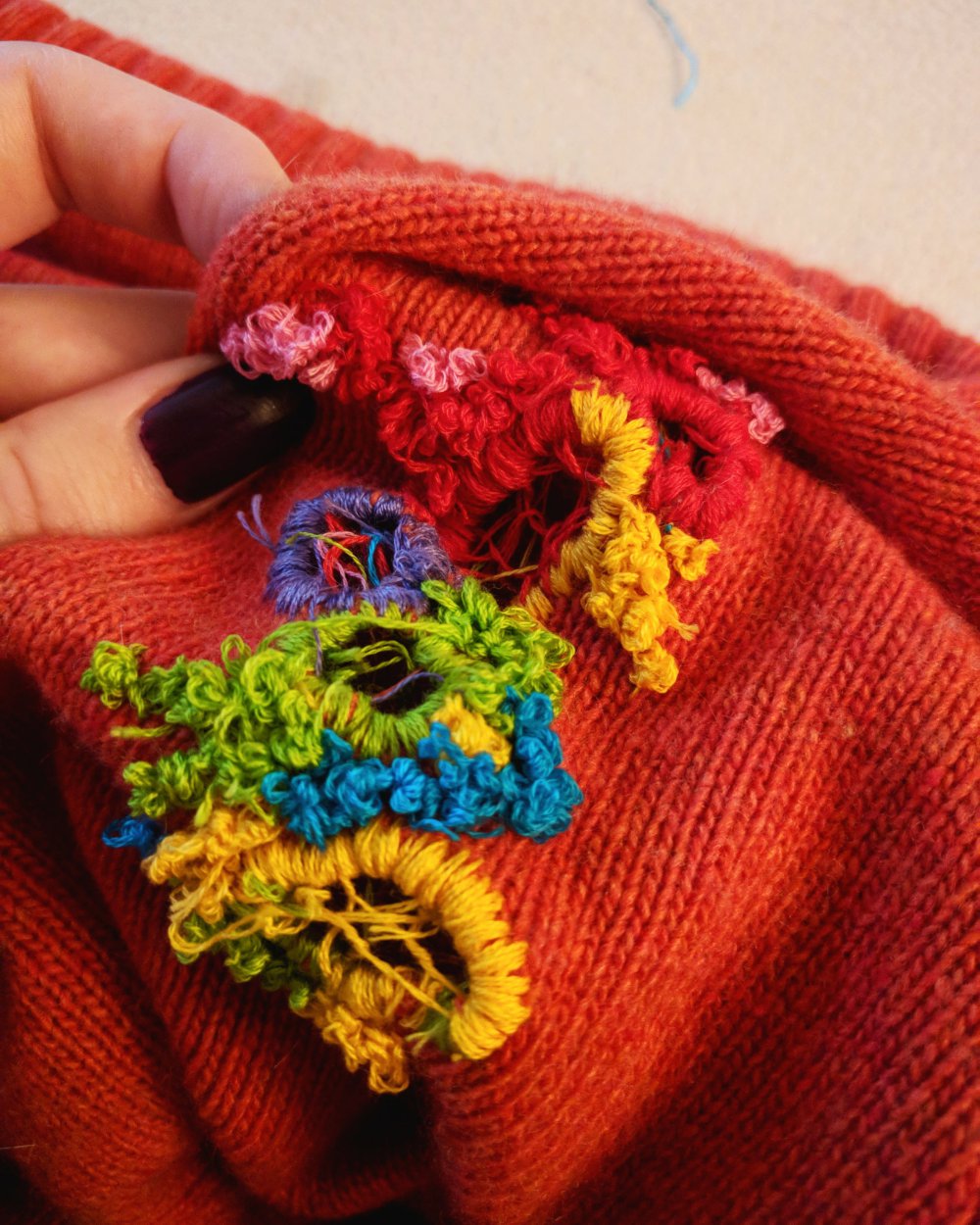
JPC: One of the things that you mention on your site is that your project works to counter problems of the gaze in particular and viewers’ projections onto trans, queer, and disabled bodies. How do you navigate this as an artist working in a visual medium?
LR: So something that was really exciting to me was how quickly trans people connected to the stories I was telling. Because my story is inherently trans and really talks about the violence that happens to trans and disabled people, what I found was that people were coming to me with garments that were really attached to their trans story. Like, “This is the first sweater I wore where I looked in the mirror and I felt like the gender I was supposed to be.” And now it’s really worn out because this person loves this garment. And instead of them retiring it, I’m embellishing these wounds in their garment and turning it into this beautiful decoration so that when people see them, they’re going, “Hey that’s like the sickest sweater I’ve ever seen. How did you get that?” And it gives that person an opportunity to take pride in their transition, if they want to. And also to just talk about like how savvy they are and how into art they are and how connected.
I really wanted to move away from like, “Oh, I would never have guessed that you’re trans,” which is supposed to be some sort of congratulations or like, “Why don’t you get top surgery?” A lot of people, the first thing they ask of a trans person is like, “Well, have you had the surgery?” and that’s really weird. They’ll ask any type of trans person, like nonbinary or like transmasculine, these really naive questions.
But instead, it’s like their trans story is attached to this beautiful thing that they’re wearing, that only they have, that someone else has poured hundreds of hours of work into. It really fosters a sense of empathy, I think, and common identity. And like I always think that the best way to compliment someone is to say “I love your top,” or “I love that color,” because it’s not about their body or anything. It’s just who they are. And like when something works for someone you can tell it’s because it mixes with their energy perfectly. So you can always compliment someone. You can always do it in a non-creepy way. This is a help for trans people in particular and disabled people as well.
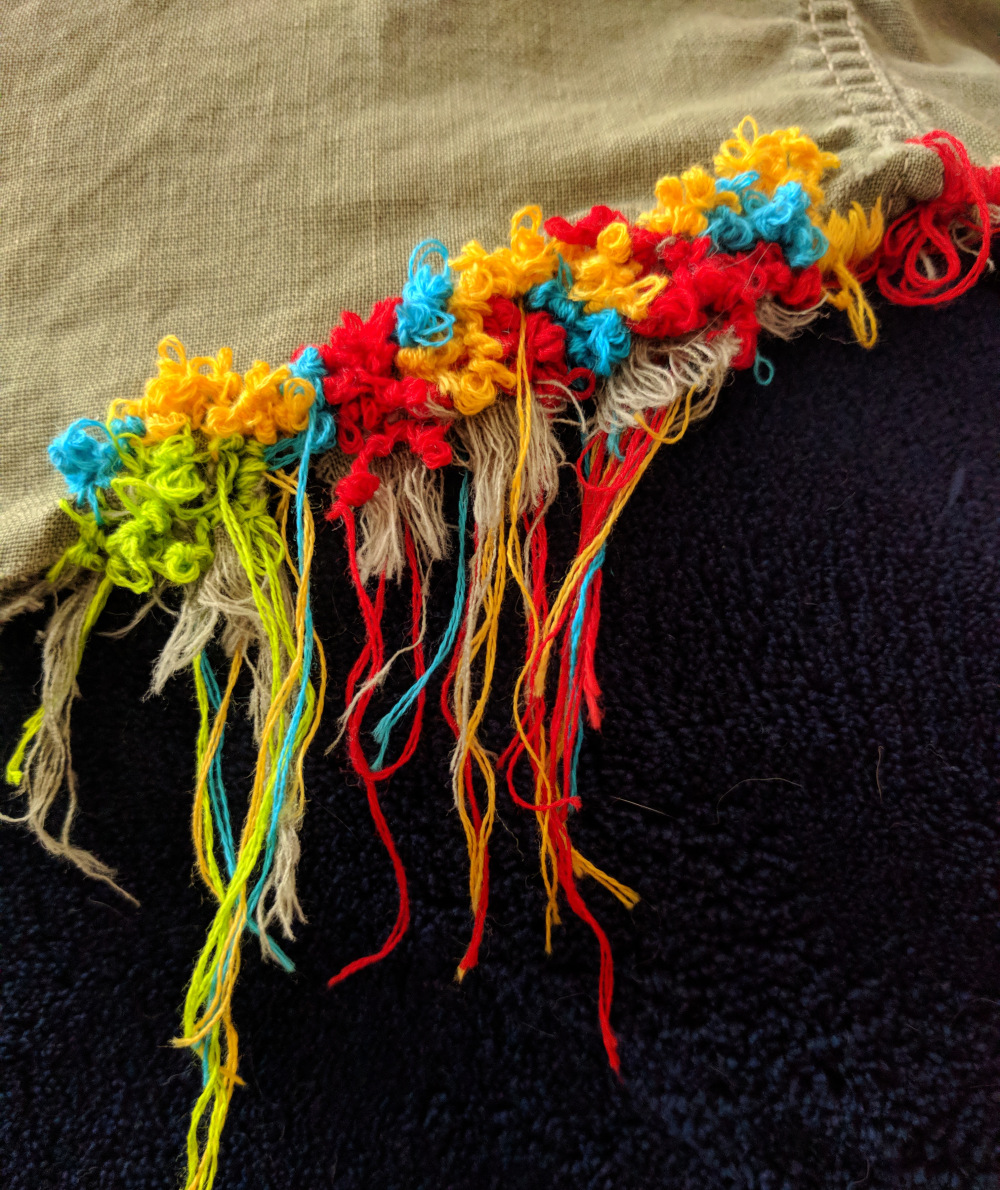
JPC: And you work with the person who’s commissioning the work to kind of work their story into it?
LR: It depends. Sometimes they tell me the story. Sometimes they just drop the garment off and what I usually find is that I pick up on their energy. I sit with the garment and meditate with the garment. I make a lot of non-intuitive decisions when I’m working with the garment and every time that happens, I’m thinking this is probably more in line with the person that this is for and not with my taste. That’s why I come up with really interesting and vivid color combinations. They’re not things that I would necessarily have done for myself. They’re more like, I can’t get that color out of my mind as I’m sitting with the garment, and I feel really strongly that this is what it needs to look like.
I had the experience where someone gave me a garment from a friend that a lot of people, community members, had in common, but who had died the year before — I had never had the chance to meet this person. But I had the experience of showing the work as it was in progress to people who knew that person, and seeing them like break into tears and being like, “It’s like I can feel that person here again.” And so I feel really confident about whatever is happening. I really try to lean into the imperfections and irregularities because I think that’s where the person is. So it’s sort of a collaborative process but also a very inspired process for me.
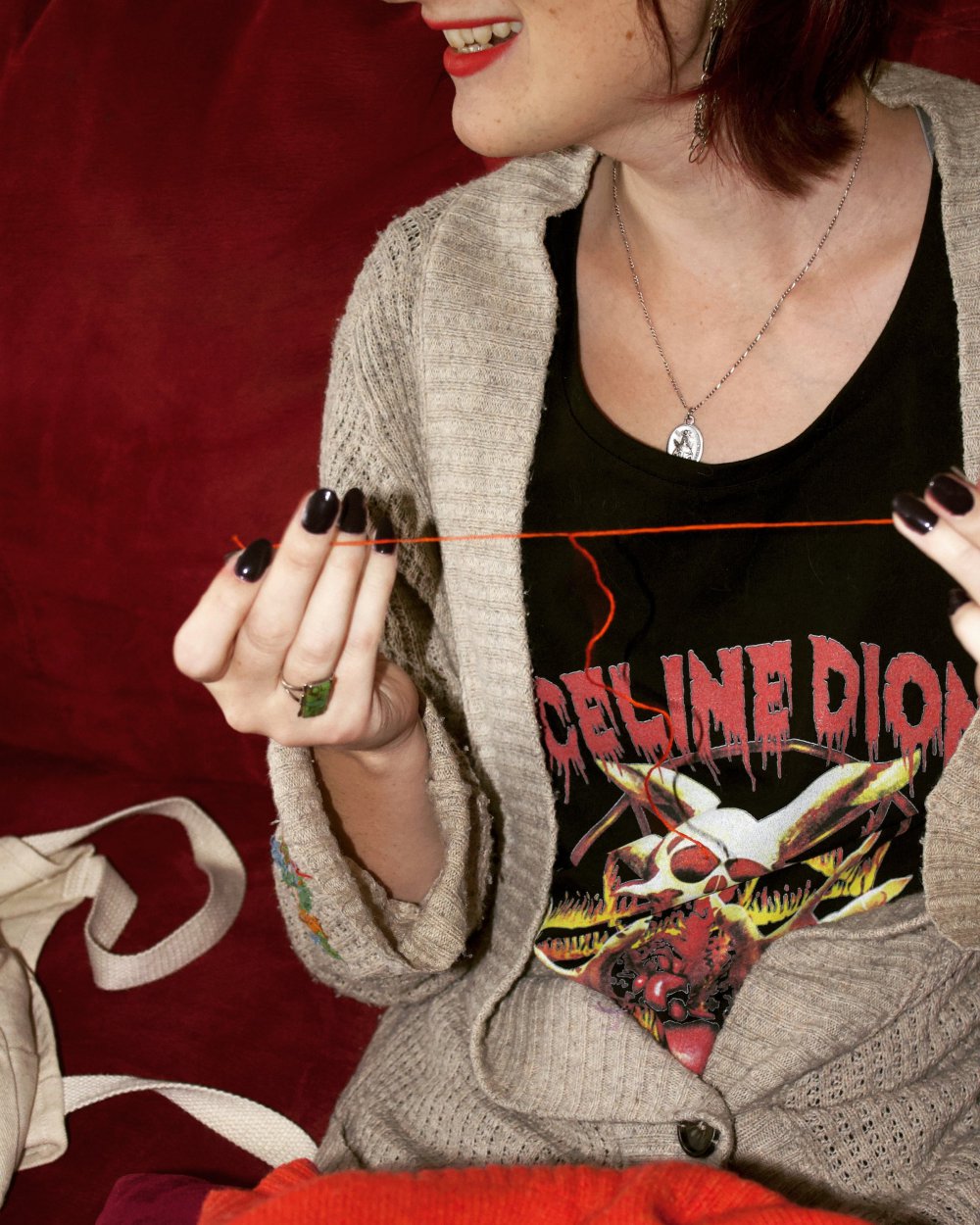
JPC: Why are you choosing to use damaged garments in particular in your work? And how do you personally relate to fashion?
LR: Most of the parenting and education I had as a little kid came from “Reading Rainbow.” I wasn’t allowed to go to school, my parents completely neglected us, and really inhibited what we were allowed to watch. But “Reading Rainbow” in particular — I still think I draw my sense of values from the books they read. And there’s one in particular and I bet it’s because it’s about this Eastern European, obviously Jewish grandpa, so I really identified with this story already. I think it was a quilted or collaged illustrated children’s book about this man’s beautiful tailored shirt and how it changes through the decades as a garment. The sleeves wear and it becomes a vest, then it becomes a tie and then it becomes patches and then it becomes like part of a quilt. So that always stuck in the back of my Virgo head as like, “I should be doing that with my clothes.”
For me, I’m really, really psychically sensitive and I couldn’t stand wearing used clothes as a kid. I’ve gotten used to it as an adult. I like to thrift and I use a lot of hand-me-downs, but I really love garments that have spent a long time with me because they’ve gone through multiple style changes with me. They’ve always fascinated me. There’s something about them that I really identify with. And I don’t want to think of them as damaged as they age. I want to think of them as more precious. And I think that is probably an analogy for how I grew up in a cult as a kid, and was told that because I had been trafficked that I was damaged, which meant no one would ever love me. I really wrestled with it, in my dating life, in my sex life in particular, really wrestled with my sense of self-worth. I’ve had to do a lot of work around that. And I’ve had to really lean into the idea that, well, I live in this body where my parents’ clients broke my bones and didn’t allow me to have medical help, and now I have to walk with a cane before I’m 30. I’m always going to be in crippling pain. And I will probably always have PTSD and I will probably always lose my memory.
And you know, there’s nothing I can change about that. I’m in a sense terribly, irreparably damaged in a completely disabling way. But also, like Frida says, “Feet, what need do I have of you if I have wings to fly?” My life grows a different way … I’ve really enjoyed the process of my body aging. I feel much more like myself the older I get … And objects become sacred the more attention you give to them. And I want everything around me to feel that way. It’s in a mutual relationship with me. It’s in my life because I love it not because it’s what I have. I’ve made an active choice to keep it.
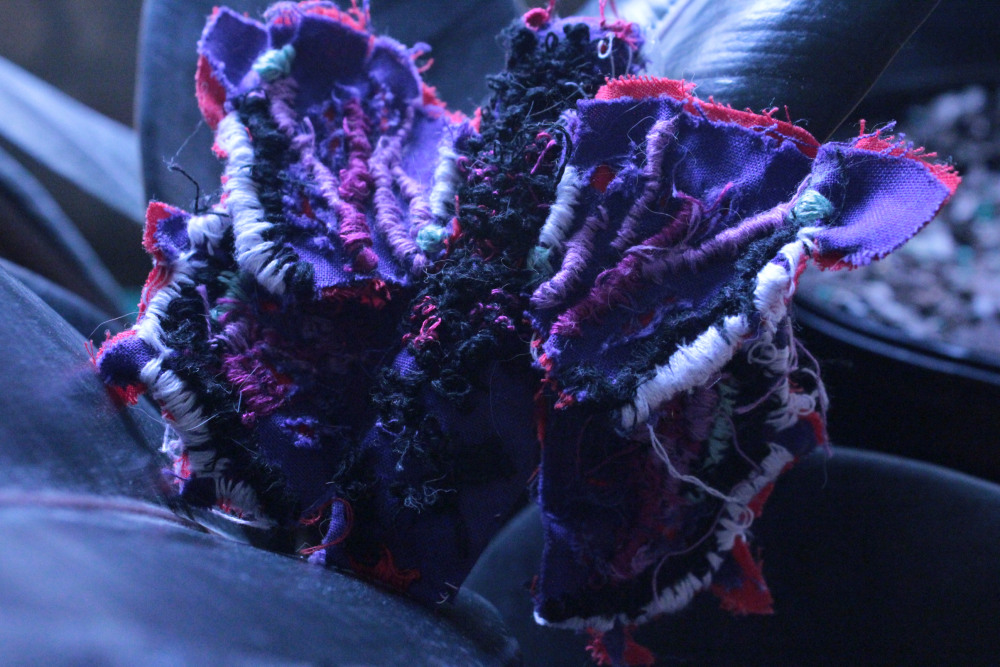
JPC: In particular, I’m really interested formalistically with your choice to embroider around holes. Because when I came upon your work, as this narrative unfolds of what you’re doing and the way trauma plays into it, I kind of expected that the embroidery would act to close the hole. I was thinking with stitching, it can have medical connotations.
LR: Yeah, and I do that with webbing a bit. But that is a fundamental philosophical thing because some places will just never heal. When I think about my childhood trauma, if I think about it for very much I get extremely depressed, like cripplingly depressed. I’ve had to really come to terms with saying, “Well, that makes sense.” Like, absolutely. That place is filled with grief and also I can move around it. I don’t have to fix it. Because I don’t think it’s a reasonable goal to fix it. But there’s so much good in my life. The process of interacting with those really big wounds has actually brought me the biggest blessings in my life. I don’t have a family, but it brought wonderful soulmates into my life, and my friend group is the type of friend group that all of my friends love each other, and get along with each other, and think really highly of each other.
So it’s reasonable to show records of crossing it and it’s reasonable to web over it. Also there is this thing of how the garments I started with had moth holes, and I really wanted my process to echo the process of a moth consuming material and changing that into living matter. The whole idea being that the hole is there because something else lived instead. It was turned into living matter. Like the hole would never be the same. You can change it. I like to make webs across it, like a cocoon almost. It’s beautiful in itself. That hole became another living being. That’s so cool.
JPC: So you mentioned accessibility being an issue with your art. How do you navigate barriers you encounter?
LR: I think part of it is that I have solved the problem that many artists haven’t. My art is already on display all the time out in the world. And that’s meant to be a portion of the performance: other people interacting with it and telling the stories behind it. That’s a part of the art.
And so in that sense it’s always being performed and I’m a part of that. And that’s a really important thing to me because I can’t get out into the world very much. I still feel connected to the world this way. And then the other part of it is documenting. So I’m performing publicly on social media. I have videos of me sewing and videos of and photos of my process. And I’m doing that intentionally in a public way. That’s a part of making it public. I think that’s the way I’m going to have to start accommodating my disability now as my mobility has gotten more constricted. I just went through a couple of months where I was very out of it so I wasn’t able to leave the house by myself safely. I think moving forward, my events are going to be more planned. I may do a couple of guerrilla events, but with like an hour or two notice ahead of time and with someone to document with me. And then I would really like to ultimately arrange performances inviting other people to come and create a domestic space with me … so more of a fireside chat, which is like a famous example of turning a domestic space into a public place or a public space into a domestic space. And that’s really the spirit of it.
Featured image: Two embroidered hearts on denim fabric. The hearts are each on either side of a seam. One heart is yellow with red, light pink, and blue stitching. The other is red with blue, purple, and orange stitching. Image courtesy of the artist.
 Jennifer Patiño Cervantes was born on the Southwest Side of Chicago with roots in Mexico. She is a freelance writer, poet, essayist, and Director of Operations + Archives for Sixty Inches From Center. She graduated from Columbia College with a degree in Art History and double minors in Poetry and Latino/Hispanic Studies. She is currently pursuing her MLIS at the University of Illinois at Urbana-Champaign.
Jennifer Patiño Cervantes was born on the Southwest Side of Chicago with roots in Mexico. She is a freelance writer, poet, essayist, and Director of Operations + Archives for Sixty Inches From Center. She graduated from Columbia College with a degree in Art History and double minors in Poetry and Latino/Hispanic Studies. She is currently pursuing her MLIS at the University of Illinois at Urbana-Champaign.
